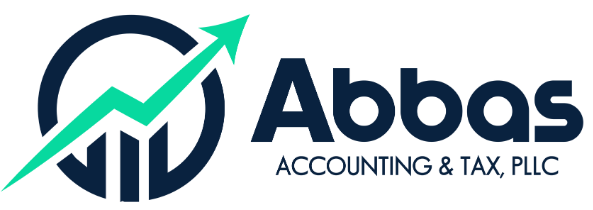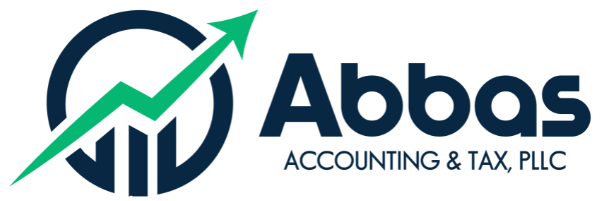How to Pay Yourself as a Business Owner in Texas (LLC vs. S-Corp Explained)
Wondering how to pay yourself as a Texas business owner? Learn the difference between an owner’s draw and an S-Corp salary, stay compliant, and maximize tax savings. Your approach affects your tax bill, your risk, and your ability to reinvest profits.
Keep records clean while you pay yourself with our Monthly Bookkeeping Services.
In This Guide
- Why It Matters: Personal Pay vs. Business Income
- How to Pay Yourself as a Texas LLC Owner
- How to Pay Yourself as an S-Corp Owner in Texas
- Owner’s Draw vs. Salary – Which Is Right?
- How Much Should You Pay Yourself?
- Common Mistakes to Avoid
- How Abbas CPA Helps
- Final Takeaways
- Book a Free CPA Consultation
Why It Matters: Personal Pay vs. Business Income
As a business owner, you don’t simply cut yourself a paycheck like a regular employee. You need to understand how your entity is taxed (LLC or S-Corp), what portion counts as income versus distributions, and what the IRS expects from your compensation model.
(Long-tail: how to pay yourself as an LLC or S-Corp in Texas)
How to Pay Yourself as a Texas LLC Owner
Single-Member LLC (Sole Proprietor Taxation)
If you are the only owner and haven’t elected S-Corp status, you’ll pay yourself with an owner’s draw:
- Transfer money from the business account to your personal account.
- No payroll setup required.
- Taxes are paid on your personal return via Schedule C (Form 1040).
CPA Tip: keep business and personal accounts separate for clean records. Need help setting up QuickBooks rules and categories? Explore our Bookkeeping Services.
Multi-Member LLC (Partnership Taxation)
Each owner typically receives distributions based on their ownership percentage. Payments are not “wages” but draws. You’ll receive a Schedule K-1 reporting your share of income; profits can be taxable even if you do not withdraw them.
(LSI: partnership distributions, K-1 income, multi-member LLC payment)
How to Pay Yourself as an S-Corp Owner in Texas
You Must Run Payroll
After electing S-Corp status (Form 2553), active owners must receive a reasonable salary. That salary is subject to Social Security and Medicare taxes, so you’ll need a payroll system (e.g., Gusto) or a CPA. In addition, you can take distributions, which are not subject to payroll taxes.
Example:
- Salary: $60,000 (W-2, taxed)
- Distribution: $40,000 (not subject to self-employment tax)
- Total compensation: $100,000
See the IRS guidance for elections: Form 2553.
Run payroll correctly and keep records tidy with our monthly bookkeeping, or get help choosing an entity via Entity Formation Services.
Owner’s Draw vs. Salary – Which Is Right for You?
| Factor | Owner’s Draw (LLC) | Salary + Distribution (S-Corp) |
|---|---|---|
| Self-Employment Tax | Full amount taxed (~15.3%) | Only on salary portion |
| IRS Compliance | Simple | Requires payroll setup & W-2 filing |
| Paperwork Requirements | Minimal | Payroll filings, 1120-S return, W-2s |
| Tax Planning Flexibility | Low | High (split-income strategy) |
(Long-tail: owner’s draw vs salary Texas small business)
How Much Should You Pay Yourself?
There’s no one-size-fits-all rule, but consider:
- Your business’s cash flow and runway.
- The market rate for your role.
- Your personal expenses and goals.
- IRS guidance on reasonable compensation.
Benchmarking tools: Use sources such as Glassdoor and Payscale, plus industry reports, to justify your S-Corp salary.
CPA Tip: document your reasoning and keep it with your payroll files in case of an IRS audit. For ongoing planning, pair with our Small Business Accounting.
Common Mistakes Business Owners Make
- Taking 100% of profits without planning for taxes.
- Failing to set up payroll after electing S-Corp.
- Mixing personal and business accounts.
- Paying personal bills directly from the business.
- Skipping quarterly estimated payments.
Unsure about quarterlies? Read our Quarterly Taxes in Texas guide or get help via Tax Preparation Services.
How Abbas CPA Helps Texas Business Owners Pay Themselves Right
- Choose the right entity for tax savings.
- Set up compliant payroll for S-Corps.
- Balance salary and distributions.
- Stay on top of IRS rules year-round.
- File accurate W-2s, K-1s, and 1120-S forms.
Whether you’re a solo LLC or a growing S-Corp, we’ll align compensation with your goals. Schedule a free consultation with our Houston CPA team.
Final Takeaways – How to Pay Yourself Properly
- LLC owners typically use an owner’s draw.
- S-Corp owners must run payroll and can take distributions.
- Tax planning is essential to maximize savings and avoid penalties.
- Working with a CPA keeps you compliant, organized, and profitable.
Ready to Set Up Your Pay the Right Way?
Let our expert CPA team in Houston help you with payroll, distributions, and tax savings.
Schedule a free consultation with Abbas Accounting & Tax PLLC
Related Posts

Understanding Small Business Tax Deductions
Explore top deductions including home office, depreciation, and retirement plans for 2025.
Read More
Quarterly Bookkeeping Tips for Texas Businesses
Learn how to stay compliant and audit-ready each quarter with these proven bookkeeping tips.
Read More
EXCELLENTTrustindex verifies that the original source of the review is Google. Haider is an exceptional accountant. His CPA background and exceptional knowledge of the US tax code has been a great asset to my businesses. His work is very clean and thorough, while always making an effort to communicate with me each step of the way. I would highly recommend him for anyone looking to grow their business!Trustindex verifies that the original source of the review is Google. My husband and I can not tell you how grateful we are for Abbas Accounting & Tax. Haider is so helpful and very very knowledgeable. So many of our neighbors recommended him and we are glad we reached out. We now feel confident and actually have an understanding on how we SHOULD fill out our W4 and our taxes. We finally have a trusted tax & accounting expert that we will continue to utilize every year! Thank you!Trustindex verifies that the original source of the review is Google. I had an excellent experience with Abbas Accounting & Tax in Richmond. Their team is professional, knowledgeable, and genuinely cares about helping their clients. Haider Abbas made the process simple and stress-free, providing clear explanations every step of the way. Their expertise saved me both time and money on my taxes. I highly recommend Abbas Accounting & Tax to anyone seeking reliable, trustworthy, and friendly accounting services.Trustindex verifies that the original source of the review is Google. Haider has been incredibly helpful in guiding me through my tax filing process and helping me understand the advantages available to me. He took the time to explain everything clearly, making sure I was informed and confident in my decisions. Beyond just taxes, Haider also provided valuable insights into forming my LLC, helping me structure it in a way that benefits me both financially and legally. His expertise, professionalism, and willingness to go the extra mile truly set him apart.Trustindex verifies that the original source of the review is Google. I've known Haider Abbas for many years, and I can confidently say he is one of the most knowledgeable and trustworthy CPAs out there. He genuinely cares about his clients and takes the time to explain everything in a way that makes sense. Whether it’s tax preparation, accounting, or financial advice, he goes above and beyond to ensure accuracy and maximize savings. His professionalism, attention to detail, and commitment to client success truly set him apart. If you're looking for a reliable CPA who will always have your best interests in mind, especially when tax season is upon us, I highly recommend Abbas Accounting & Tax!Trustindex verifies that the original source of the review is Google. He’s done our taxes for over ten years and has saved us so much money every year. Haider has great knowledge and expertise with the ability to communicate effectively and adapt to our needs. It has been a pleasure working with him for over a decade! Highly recommend.Trustindex verifies that the original source of the review is Google. Best place to get your taxes done. Haider has great knowledge & expertise to handle your business or personal taxes.Trustindex verifies that the original source of the review is Google. Great service. Haider Abbas explains taxes in a simple manner and helps to make sure you are getting your full refund, by knowing the tax laws so well. Would highly recommend to everyone!Verified by TrustindexTrustindex verified badge is the Universal Symbol of Trust. Only the greatest companies can get the verified badge who has a review score above 4.5, based on customer reviews over the past 12 months. Read more


